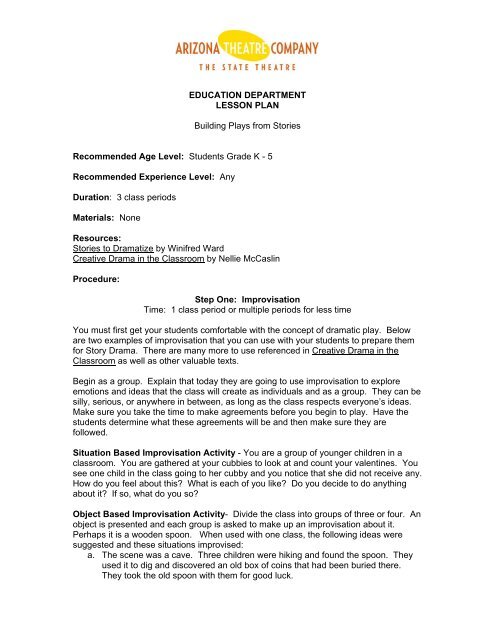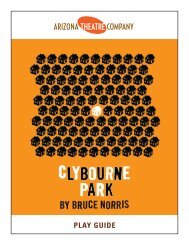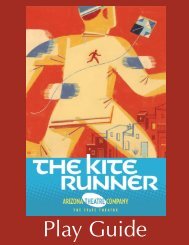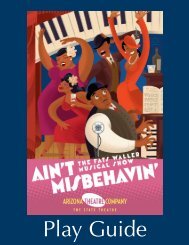Building Plays from Stories - Arizona Theatre Company
Building Plays from Stories - Arizona Theatre Company
Building Plays from Stories - Arizona Theatre Company
Create successful ePaper yourself
Turn your PDF publications into a flip-book with our unique Google optimized e-Paper software.
EDUCATION DEPARTMENTLESSON PLAN<strong>Building</strong> <strong>Plays</strong> <strong>from</strong> <strong>Stories</strong>Recommended Age Level: Students Grade K - 5Recommended Experience Level: AnyDuration: 3 class periodsMaterials: NoneResources:<strong>Stories</strong> to Dramatize by Winifred WardCreative Drama in the Classroom by Nellie McCaslinProcedure:Step One: ImprovisationTime: 1 class period or multiple periods for less timeYou must first get your students comfortable with the concept of dramatic play. Beloware two examples of improvisation that you can use with your students to prepare themfor Story Drama. There are many more to use referenced in Creative Drama in theClassroom as well as other valuable texts.Begin as a group. Explain that today they are going to use improvisation to exploreemotions and ideas that the class will create as individuals and as a group. They can besilly, serious, or anywhere in between, as long as the class respects everyone’s ideas.Make sure you take the time to make agreements before you begin to play. Have thestudents determine what these agreements will be and then make sure they arefollowed.Situation Based Improvisation Activity - You are a group of younger children in aclassroom. You are gathered at your cubbies to look at and count your valentines. Yousee one child in the class going to her cubby and you notice that she did not receive any.How do you feel about this? What is each of you like? Do you decide to do anythingabout it? If so, what do you so?Object Based Improvisation Activity- Divide the class into groups of three or four. Anobject is presented and each group is asked to make up an improvisation about it.Perhaps it is a wooden spoon. When used with one class, the following ideas weresuggested and these situations improvised:a. The scene was a cave. Three children were hiking and found the spoon. Theyused it to dig and discovered an old box of coins that had been buried there.They took the old spoon with them for good luck.
. The scene was a settler’s cabin over 100 years ago. The family had very fewhousehold items and so they prized each one. Among them was a woodenspoon. In this scene it was used to stir batter for cornbread and then waswashed and carefully put away.c. The scene was a museum and the spoon a relic <strong>from</strong> the Native Americans whoonce inhabited the region. The characters are a curator and two children visitingthe museum. The curator answered their questions by telling them the history ofthe spoon.d. The scene was an industrial arts class. The students are making things of wood,and a blind student carved the spoon. It was so well done that the teacher saidshe would display it as one of the best things made in class that year.Step 2: Telling (or reading) the StoryTime: 20 minutesAfter students are comfortable with improvisation, you can begin to use stories andstorytelling to build plays in your classroom. Folk tales, legends, and fables arerecommended for use on all levels; though they will be differently interpreted due tomaturity and experience.You can either read or tell the story. In general, telling the story is preferable because itestablished a closer rapport with the class and gives the teacher a chance to observethe listeners’ responses and to clarify, as he or she goes along, any points that appear topuzzle them. The teacher must be thoroughly familiar with the material; in fact, thebeginning teacher will do well to practice telling the story aloud before presenting to thegroup.Step 3: Ask and Answer QuestionsClarifying the StoryTime: Questions - 15 minutesTag - 10 minutesAfter the story has been told, questions should be asked and answered. The childrenare ready to beginning planning how they will handle the story. A discussion shouldinclude a review of the plot and descriptions of the characters. This may be a good timeto add a game of Story Tag. Story Tag is a fun way to review the plot of the story.Here is how it works:Find some sort of soft, safe toy that can be passed <strong>from</strong> player to player. In thisgame, employ the walking rule. Give one player the tag toy and have them begintelling the story. As the story is told, the player moves around the room to taganother player with the toy. At this point, the next person starts the story <strong>from</strong>where it left off. Let everyone know ahead of time that if they should forget a partof the story, it is OK. They can simply add their own details for it to make sense.This game is an excellent warm up and a great way to begin generating ideas forstory development.The discussions that precede and follow each playing are important aspects of creativedramatics, for it is during these periods that some of the most creative thinking takesplace. Some questions that precede the first playing are:
1. What do we want to tell?2. Who are these people?3. What are these people really like?4. What are they doing when we first meet them?5. Where does the first scene take place?6. What kind of house do they live in?Step 4: Playing the StoryTime: Varies greatly depending on your students and your needs. It also depends on ifyou just keep playing the story or if you use interview, tableau, group improvisation.When the details have been secured, the leader should suggest that the students beginplaying the story. Asking for volunteers is a good way of starting. Casting can be doneon a voluntary basis the first two or three times. Later, the leader can start suggestingthat other children try various parts; for instance: “Lynne hasn’t had a chance yet. Howwould you like to try the princess this time, Lynne?” or “John has been the cobbler. Let’sgive Alan a chance to play it. And you, John, be one of the townsfolk.” It is thedevelopment of each participant that concerns us. Later, when the group is ready to playthe story for the last time, the leader might suggest those students who have brought themost reality to each part, but this is as close as we come to typecasting.If students are unsure where to begin, you can begin with tableau or slide show format.Have the student begin playing and when they hear the word “CLICK” they should freezein a tableau. This way you can talk and get ideas <strong>from</strong> the kids when they become afrozen picture. Ask certain characters to give appropriate lines of dialogue.After the scene has been played once, more specific questions can guide thediscussion. They might be:1. Did they tell the story?2. What did you like about the opening scene?3. Did the people should that they were excited (angry, unhappy, etc.)?4. When we play it again, can you think of anything that would improve it?5. Was anything important left out?The situation may be played many times, but the replaying should not be interpreted asrehearsal It is hoped with each replaying that greater insights are gained, that the storygains depth and substance, and that each participant develops greater freedom and selfconfidence.Initial results will be crude and superficial. Dialogue will be scanty, despite the mostcareful planning. This does not represent failure. It is an early stage in the developmentof the group and may, at that point, indicate real progress. Acceptance of effort,therefore, does not mean that the leader is satisfied to remain at this level but, rather,that he or she recognizes the efforts that have been made and is aware of the values tothose who have taken part. As the leader works with the group, he or she will becomemore selective but in the beginning will accept all ideas simply because they have beenoffered. In time, students will learn to distinguish between contributions that advance theplay and those that distract or have little to do with it.
You can use any number of stories to dramatize, but I suggest using stories that arefamiliar to the students as a place to begin. Once they become more comfortable withstory drama, you can then introduce new material.The greater the plot complications and length, the greater demand on time in planning.There is sufficient content to absorb the interest of the average class for severalsessions depending on the length of the period and the age of the participant.Characters are presented in greater depth; hence much more time must be spent ontheir development. Most groups like to consider such questions as:1. What is the character really like?2. Why does the character behave as he or she does?3. What do others think of him or her? Why?4. If the character is not like that, why do others think so?5. How is the character changed, or what has he or she learned as a result of his orher actions?As the participants grow in experience, they will find new ways of telling the story. Somewill want to use narrators; others, many scenes; and some may rearrange the sequenceof events all together. The growing self-confidence of the players releases ideas thatlead to further thinking and experimentation. Each group, regardless of age, becomesmore critical of its efforts as, with the help of the leader, it strives for a higher level ofaccomplishment.ConclusionTime: 15 minutesIt is always important to wrap up each story drama. Find out which part of the processwas the favorite for each participant. Which character did they enjoy playing? Why?Were students concerned with being “wrong”? What made them nervous? How didthey calm their nerves?






![Play Guide [356k PDF] - Arizona Theatre Company](https://img.yumpu.com/46218320/1/190x245/play-guide-356k-pdf-arizona-theatre-company.jpg?quality=85)





![[title of show] Arizona Theatre Company Play Guide 1](https://img.yumpu.com/24482689/1/190x245/title-of-show-arizona-theatre-company-play-guide-1.jpg?quality=85)


![Play Guide [1.2MB PDF] - Arizona Theatre Company](https://img.yumpu.com/11952176/1/190x245/play-guide-12mb-pdf-arizona-theatre-company.jpg?quality=85)
